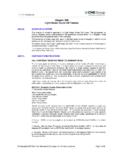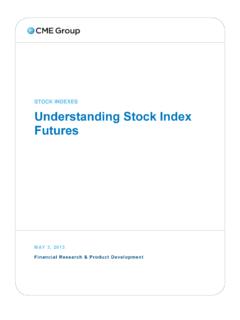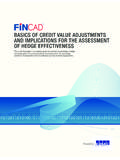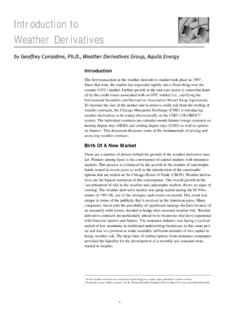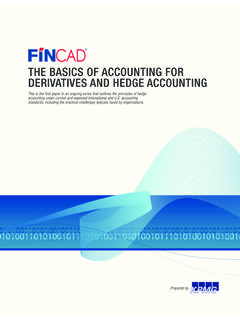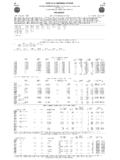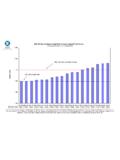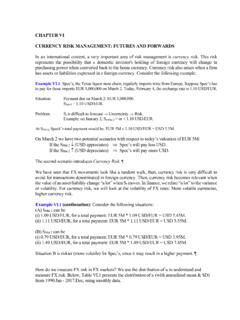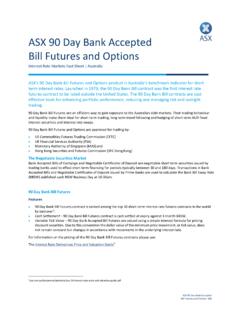Transcription of Calculating the Dollar Value of a Basis Point Final Dec 4
1 Interest Rate Research Center Tools and Analytics Calculating THE Dollar Value OF A Basis Point The objective of hedging a fixed income position with futures contracts is to insure that as the underlying security loses Value , the futures hedge compensates for this loss by gaining a comparable amount. While many may make the mistake of matching notional values or tick increments, the best way to hedge is to match the Dollar Value of a one- Basis Point change (DV01) in the yield of the underlying security and that of the hedging vehicle. In the case of Treasury futures, you have a hedging vehicle that derives its DV01 from the underlying Treasury security. Although Treasury futures have a notional coupon of 6 percent, they are not coupon bearing instruments since they do not have cash flows. Treasury futures track the price of the most economical security to deliver, and derive their DV01 from the cash instrument they track. In most cases, this instrument is the issue that is cheapest-to-deliver (CTD) into the futures contract.
2 Price-Yield Relationship of a Treasury Security A common misconception is that the DV01 of a Treasury security remains fixed as the yield of the instrument changes. In truth, the price-yield relationship of a Treasury security is nonlinear. As yields fluctuate, the DV01 of a Treasury security changes. Exhibit 1 shows the price-yield relationship of a Treasury security as depicted by the curved line. As yields increase, a Treasury security s price falls by decreasing Dollar amounts. As yields decrease, a Treasury security s price rises by increasing Dollar amounts. The line tangent to the curve represents the DV01 of a Treasury security. As yields increase, the slope of this line flattens. As yields decrease, the slope of this line steepens. This flattening and steepening of the line tangent to the curve illustrates the changing nature of a DV01 and is called convexity. The more dramatic the convexity, the more a DV01 will vary as interest rates fluctuate.
3 Calculating the DV01 of a Treasury Security There are two common ways to calculate the DV01 of a Treasury security. The first method involves Calculating a Treasury security s price sensitivity based on small incremental interest rate changes. The second method utilizes a Treasury security s modified duration. Both methods are closely related to one another. Method #1: Price Sensitivity The simplest way to calculate a DV01 is by averaging the absolute price changes of a Treasury security for a one- Basis Point (bp) increase and decrease in yield-to-maturity. This calculation will measure how much a Treasury security s price will change in response to a one-bp change in the security s yield. Let s look at the current 10-year Treasury note that is cheapest-to-deliver into the March 2009 10-Year Treasury Note futures contract: the 5-1/8s of May 15, 2016. The last trade for this note was 108-19 ( , 108 and 19-32nds or ), which represents a yield-to-maturity of The cash price represented here is $108, To determine the DV01 of this note, calculate the average absolute price change in dollars based upon a one-bp move up and down in yield.
4 Exhibit 2 shows how you would do this for the 5-1/8s of May 15, 2016. Exhibit 2: 5-1/8s of May 2016 Yield Price Absolute Price Change (Down 1-bp) $108, $ $108, - - - - - (Up 1-bp) $108, $ In this case, the average absolute change in Dollar Value of the note is $ per one-bp change in yield-to-maturity. Method #2: Modified Duration Another way to calculate the DV01 of a Treasury security is to use the security s modified duration. Modified duration is simply a measure of the weighted average maturity of a Treasury security s cash flows. As yields fall, modified duration increases. As yields rise, modified duration decreases. A higher modified duration implies that a security is more interest rate sensitive. Conversely, a lower modified duration implies that a security is less sensitive. Modified duration assumes no convexity, but for small changes in yield it s an effective measure of interest rate sensitivity that can be used to manage interest rate risk.
5 Calculating the modified duration of a bond or note can be a rather complicated procedure. Assuming that you already know what the modified duration of a bond or note is, you can use it to derive the security s DV01. For example, if the modified duration of a Treasury security is years, the DV01 of the instrument is: [ ( x Modified Duration) x Price ] x = DV01 [ ( x ) x $108, ] x = $ If you break down the formula, you find three components: a. ( x Modified Duration): The slope of the price-yield curve at the current price. b. Price: The current price from which the DV01 will be calculated. c. : Single Basis Point move. By using this formula, we see that the DV01 is based upon its sensitivity (slope), position on the price-yield curve (price), and magnitude of the rate change (one Basis Point ). A Word of Caution: These calculations are used to monitor small changes in interest rates. Since modified duration assumes no convexity (when in fact there is), the greater the rate change, the greater the error due to this assumption.
6 Calculating the DV01 of a Treasury Futures Contract The price of a Treasury futures contract typically derives from the price of the most economical Treasury security to deliver into the contract. Under most market circumstances, the price of a Treasury futures contract tracks the price of the CTD Treasury security. Since a Treasury futures contract derives its DV01 from the Treasury securities in the contract s delivery basket, it is important to know what security is being tracked. Once you have identified the CTD security and determined its DV01, you can then calculate the Treasury futures contract s DV01. Every cash note or bond that is eligible for delivery has a conversion factor. For any delivery month, each deliverable issue has a specific conversion factor that reflects its coupon and remaining time to maturity as of that delivery month. A conversion factor is the approximate decimal price at which $1 par of a security would trade if it had a 6% yield-to-maturity.
7 Let s look at the previously mentioned 5-1/8s of May 15, 2016 and the March 2009 10-Year Treasury Note futures contract (TYH9). The conversion factor for the 5-1/8s of May 15, 2016 for delivery into TYH9 is To convert the cash DV01 into a futures DV01, simply divide it by the conversion factor. Futures DV01 = Cash DV01 / Conversion Factor Futures DV01 = $ / = $ Now that we have the futures DV01 we can match it against the DV01 of any security we wish to hedge to determine the number of futures contracts we need to hedge the position. A Word of Caution: If the futures contract is used to hedge a security it does not track ( , a corporate bond, swap, mortgage security, etc.), the underlying security and the hedge will not move in tandem due to Basis risk and therefore must be monitored carefully. As interest rates change, the hedge will need to be adjusted to compensate for Basis risk. This information has been compiled by CME Group for general purposes only.
8 CME Group assumes no responsibility for any errors or omissions. Although every attempt has been made to ensure the accuracy of the information within this brochure, CME Group assumes no responsibility for any errors or omissions. Additionally, all examples in this brochure are hypothetical situations, used for explanation purposes only, and should not be considered investment advice or the results of actual market experience. All matters pertaining to rules and specifications herein are made subject to and are superseded by official CME, CBOT and CME Group rules. Current rules should be consulted in all cases concerning contract specifications. December, 2008
